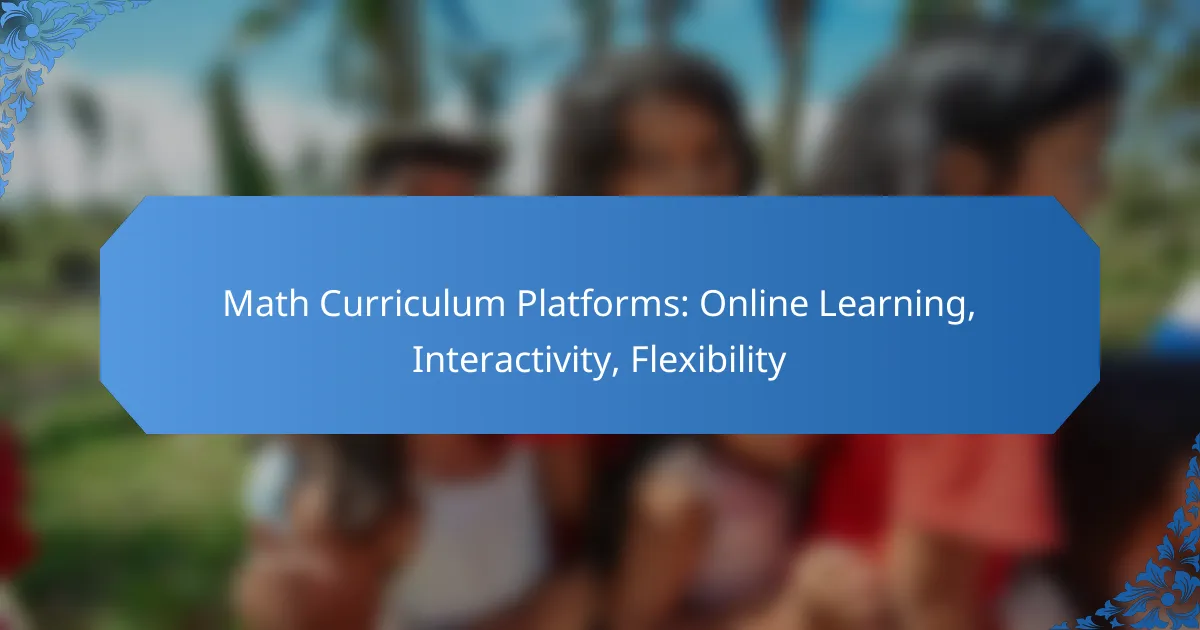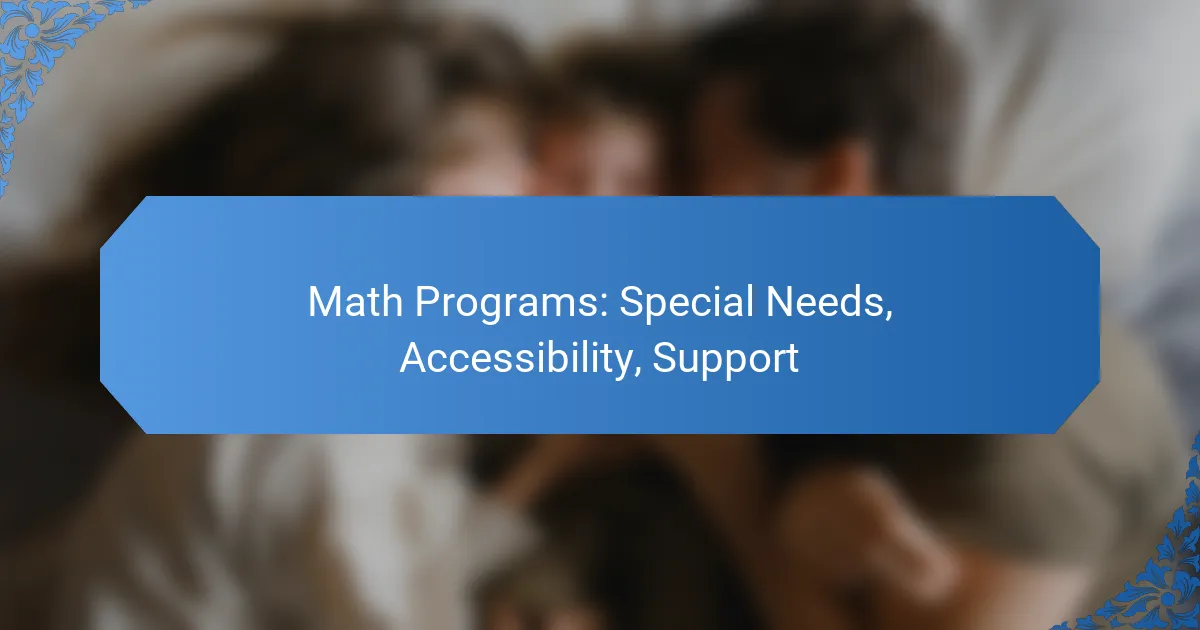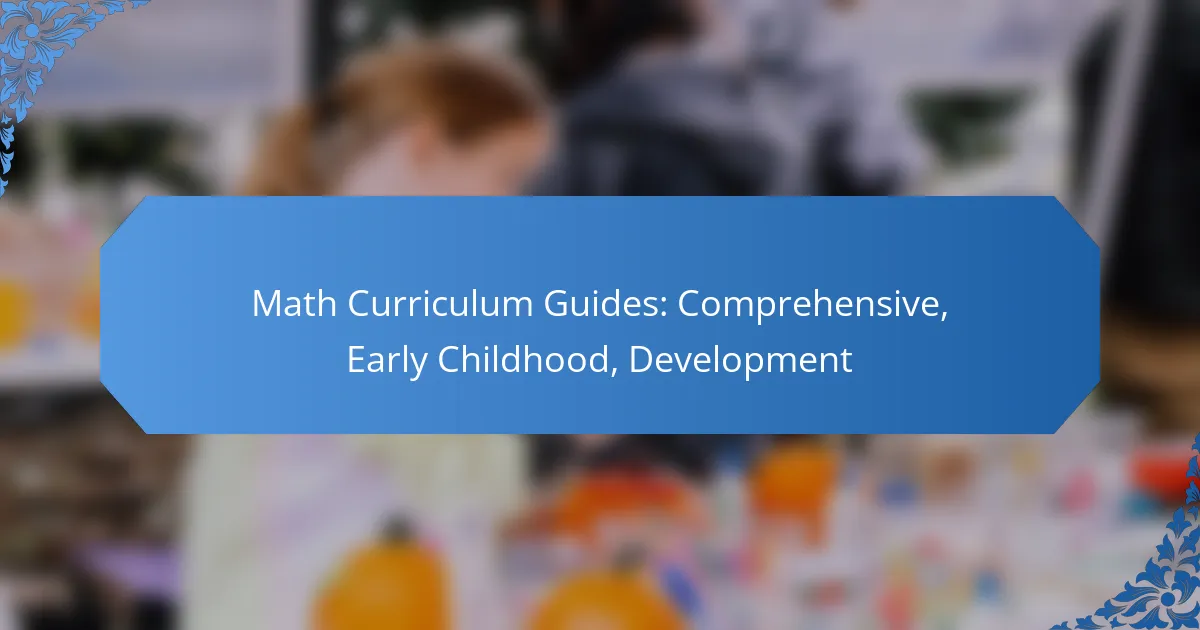Exploring budget-friendly math curriculum options allows educators and parents to provide quality education without financial strain. These resources are designed to meet diverse learning styles and grade levels while ensuring accessibility for all students, including those with special needs. By prioritizing affordability and inclusivity, a well-rounded math curriculum can effectively support academic success for every learner.

What Are the Best Budget-Friendly Math Curriculum Options?
Budget-friendly math curriculum options provide quality education without significant financial strain. These resources often include free or low-cost platforms that cater to various learning styles and grade levels.
Khan Academy
Khan Academy offers a comprehensive, free online math curriculum suitable for students from kindergarten through high school. The platform features instructional videos, practice exercises, and personalized learning dashboards that help track progress.
Students can learn at their own pace, making it an excellent option for those who need extra time on challenging concepts. The resource aligns with common educational standards, ensuring relevance and effectiveness.
IXL Learning
IXL Learning provides a subscription-based math curriculum that adapts to each student’s needs, offering personalized practice in a wide range of topics. While it requires a monthly fee, the platform’s interactive questions and immediate feedback enhance the learning experience.
IXL covers skills from pre-K to high school, making it a versatile choice for families looking for a comprehensive math solution. However, consider the cost and whether the subscription fits your budget before committing.
Mathletics
Mathletics is an online math program that combines engaging activities with a structured curriculum. It typically charges an annual fee, but many schools offer it as part of their educational resources, making it accessible to students.
The platform includes a variety of interactive games and challenges that motivate learners while reinforcing math concepts. It aligns with national standards, ensuring that students are learning relevant material.
Prodigy Math
Prodigy Math is a free, game-based learning platform that makes math fun for students in grades 1-8. While the basic version is free, there are premium features available for a fee that enhance the experience.
The game adapts to each student’s skill level, providing personalized practice and instant feedback. This approach helps maintain engagement and encourages a love for math, making it a popular choice among younger learners.
CK-12 Foundation
The CK-12 Foundation offers a free, customizable math curriculum that includes textbooks, interactive simulations, and practice problems. It caters to various learning styles and allows educators to tailor content to meet specific student needs.
With a focus on STEM education, CK-12 aligns with educational standards and provides resources for students from elementary through high school. Its flexibility and no-cost access make it an excellent option for budget-conscious families and schools.

How to Choose a Quality Math Curriculum?
Choosing a quality math curriculum involves evaluating its alignment with educational standards, reviewing feedback from other educators, and considering the resources available for teachers. A well-rounded curriculum should not only meet academic requirements but also be accessible and budget-friendly.
Accreditation and Standards
When selecting a math curriculum, ensure it is accredited and aligns with national or state educational standards. Accreditation indicates that the program has undergone rigorous evaluation and meets specific quality benchmarks.
Look for curricula that reference well-known standards such as the Common Core State Standards (CCSS) in the United States or the National Curriculum in the UK. This alignment helps ensure that students acquire the necessary skills and knowledge at each grade level.
Curriculum Reviews
Reading reviews from other educators can provide valuable insights into the effectiveness of a math curriculum. Websites, forums, and educational blogs often feature detailed assessments that highlight strengths and weaknesses.
Consider seeking out reviews that discuss user experience, student engagement, and outcomes. Pay attention to feedback regarding adaptability for different learning styles and the curriculum’s ability to foster critical thinking.
Teacher Resources
A quality math curriculum should come with comprehensive teacher resources to support instruction. Look for materials such as lesson plans, assessment tools, and professional development opportunities.
Evaluate whether the curriculum offers online support, including forums or webinars, where teachers can share strategies and ask questions. Access to these resources can significantly enhance teaching effectiveness and student learning outcomes.
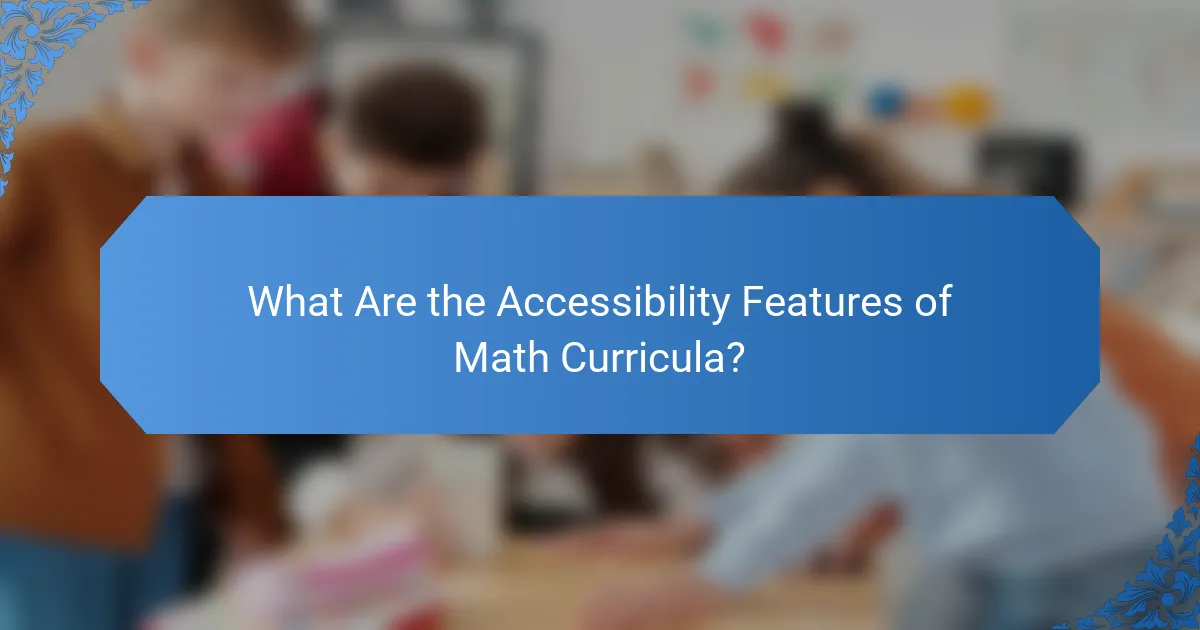
What Are the Accessibility Features of Math Curricula?
Accessibility features in math curricula are designed to ensure that all students, regardless of their learning needs, can engage with and benefit from the material. These features include adaptive technologies, language support, and accommodations for special needs, making math education more inclusive.
Adaptive Learning Technologies
Adaptive learning technologies personalize the educational experience by adjusting content based on individual student performance. These tools often use algorithms to identify areas where a student struggles and provide targeted exercises to improve understanding. For example, platforms like DreamBox or IXL adapt in real-time, offering practice problems that match the learner’s skill level.
When selecting adaptive learning tools, consider their compatibility with existing curricula and the ease of use for both students and teachers. Look for programs that offer analytics to track progress and identify trends over time.
Language Support
Language support features help students who are non-native speakers or those with language processing difficulties. Effective math curricula often include multilingual resources, glossaries, and visual aids to clarify concepts. For instance, programs that offer instructions in multiple languages can significantly enhance comprehension for diverse classrooms.
When evaluating language support, check if the curriculum provides translated materials or audio support. This can be crucial for students who may struggle with written instructions but excel with auditory learning.
Special Needs Accommodations
Special needs accommodations in math curricula are tailored to assist students with disabilities, ensuring they have equal access to learning opportunities. These may include modified assignments, additional time for tests, or the use of assistive technologies like speech-to-text software. For example, a student with dyscalculia might benefit from using manipulatives or visual representations to grasp mathematical concepts.
It’s essential to collaborate with special education professionals when implementing these accommodations. Regular assessments and feedback can help refine strategies to meet individual needs effectively, ensuring that all students can succeed in their math education.

What Are the Key Criteria for Selecting a Math Curriculum?
When selecting a math curriculum, key criteria include cost, alignment with educational standards, and overall value. A well-chosen curriculum should meet budget constraints while providing quality content that supports student learning and development.
Cost vs. Value Analysis
Cost is a significant factor in choosing a math curriculum, but it should be weighed against the value it provides. A curriculum that is inexpensive may lack depth or rigor, while a higher-priced option might offer superior resources and support.
Consider the total cost of ownership, which includes not just the purchase price but also materials, training, and ongoing support. For example, a curriculum priced at USD 300 may seem high, but if it includes comprehensive teacher training and student resources, it could be more cost-effective in the long run.
Curriculum Alignment with Standards
Ensuring that a math curriculum aligns with local and national educational standards is crucial for effective teaching and learning. This alignment guarantees that students are learning the necessary skills and concepts required for their grade level.
Review the curriculum’s scope and sequence to confirm it covers all required topics and skills. For instance, if your state follows the Common Core State Standards, check that the curriculum explicitly addresses these standards to avoid gaps in learning.
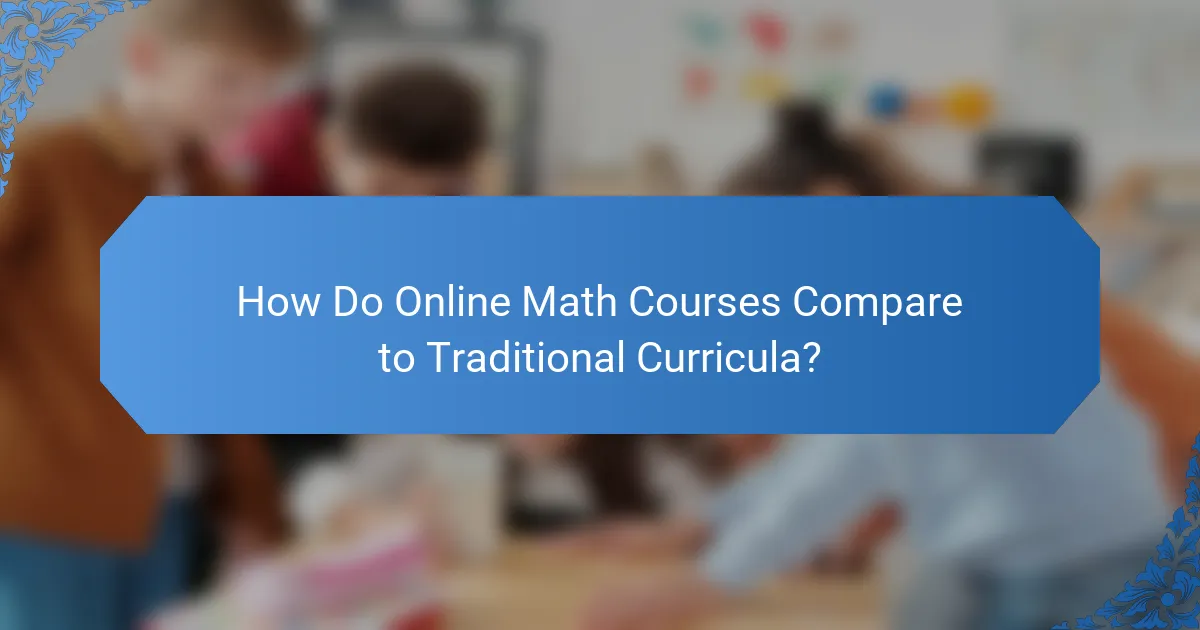
How Do Online Math Courses Compare to Traditional Curricula?
Online math courses offer a different approach to learning compared to traditional curricula, emphasizing flexibility and accessibility. While traditional methods often rely on in-person instruction, online options provide a range of formats that can cater to diverse learning styles and schedules.
Flexibility and Convenience
Online math courses allow learners to study at their own pace, making it easier to fit education into busy schedules. Students can access materials anytime, which is particularly beneficial for those balancing work or family commitments.
For example, many online platforms offer courses that can be completed in a few weeks to several months, depending on the learner’s availability. This flexibility can lead to better retention of material, as students can revisit challenging concepts as needed.
Interactive Learning Experiences
Many online math courses incorporate interactive elements such as quizzes, video tutorials, and discussion forums, enhancing engagement compared to traditional lectures. These features often encourage active participation, allowing students to practice problems and receive immediate feedback.
Additionally, some platforms utilize adaptive learning technologies that tailor the curriculum based on individual performance, ensuring that learners focus on areas where they need improvement. This personalized approach can significantly boost understanding and retention of mathematical concepts.

What Are the Trends in Math Curriculum Development?
Current trends in math curriculum development emphasize the integration of technology and a strong focus on STEM education. These trends aim to enhance student engagement and improve learning outcomes by making math more relevant and accessible.
Integration of Technology
The integration of technology in math curricula involves using digital tools and resources to facilitate learning. This can include interactive software, online platforms, and virtual manipulatives that allow students to explore mathematical concepts in a dynamic way.
For example, platforms like Khan Academy or IXL provide personalized learning experiences, enabling students to progress at their own pace. Schools should consider investing in devices and software that align with their curriculum goals to maximize the benefits of technology integration.
Focus on STEM Education
A focus on STEM (Science, Technology, Engineering, and Mathematics) education in math curricula encourages students to apply mathematical concepts to real-world problems. This approach fosters critical thinking and problem-solving skills that are essential in today’s job market.
Incorporating project-based learning and interdisciplinary activities can enhance student interest and understanding of math. Schools should aim to create partnerships with local businesses and organizations to provide students with practical experiences that connect math to various fields.
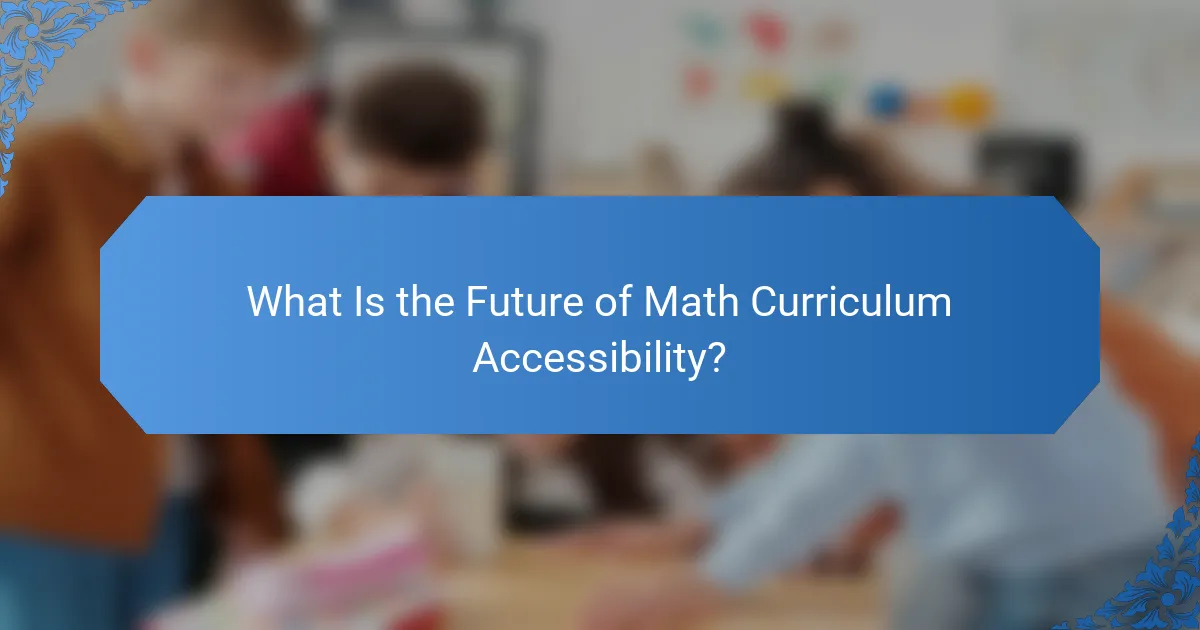
What Is the Future of Math Curriculum Accessibility?
The future of math curriculum accessibility focuses on providing equitable educational resources that cater to diverse learning needs. This includes affordable materials, digital platforms, and inclusive teaching methods that ensure all students can engage with math effectively.
Budget-Friendly Options
Budget-friendly math curriculum options are essential for schools and families looking to minimize costs while maintaining quality. Many online platforms offer free or low-cost resources, such as Khan Academy or OpenStax, which provide comprehensive math courses and materials.
Additionally, consider using community resources like local libraries, which often have free access to educational software and textbooks. Schools can also explore partnerships with educational nonprofits that provide subsidized materials.
Quality Curriculum Choices
Quality in math curriculum is determined by alignment with educational standards and effectiveness in promoting student understanding. Look for programs that are research-based and have proven success in improving student outcomes.
Popular quality curricula include Singapore Math and the Eureka Math program, both of which emphasize conceptual understanding and problem-solving skills. Evaluating reviews and testimonials from other educators can help in selecting the right program.
Accessibility for All Learners
Ensuring accessibility in math curricula means accommodating various learning styles and needs. This can involve using differentiated instruction techniques, such as visual aids, manipulatives, and technology-enhanced learning tools.
Incorporating Universal Design for Learning (UDL) principles can further enhance accessibility by providing multiple means of engagement, representation, and action. Schools should also consider training teachers in inclusive practices to better support all students, including those with disabilities.

